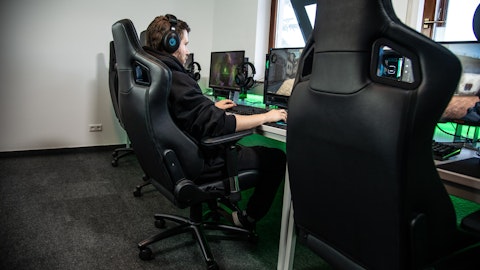Corsair Gaming, Inc. (NASDAQ:CRSR) Q4 2022 Earnings Call Transcript February 9, 2023
Operator: Good afternoon and welcome to the Corsair Gaming Fourth Quarter and Full Year 2022 Earnings Conference Call. As a reminder, today’s call is being recorded and your participation implies consent to such recording. With that, I will now turn the call over to Ronald Van Veen, Corsair’s Vice President of Finance and Investor Relations. Thank you, sir. You may begin.
Ronald Van Veen: Thank you. Good afternoon, everyone and thank you for joining us for Corsair’s financial results conference call for the fourth quarter and full year ended December 31, 2022. On the call today, we have Corsair’s I, Andy Paul; and Michael Potter. Andy will review highlights from the full year fourth quarter 2022. Michael will then review the financials and our outlook. We will then have time for any questions. Before we begin, allow me to provide a disclaimer regarding forward-looking statements. This call, including the Q&A portion of the call, may include forward-looking statements related to the expected future results of our company and are therefore forward-looking statements. Our actual results may differ materially from our projections due to a number of risks and uncertainties.
The risks and uncertainties that forward-looking statements are subject to are described in our earnings release and on our SEC filings. Note that until our 10-K has been filed, these numbers are preliminary. Today’s remarks will also include references to non-GAAP financial measures. Additional information, including reconciliation between non-GAAP financial information to the GAAP financial information, is provided in the press release we issued after the market close today. With that, I’ll now turn the call over to Andy.
Andy Paul: Thank you, Ronald and welcome, everyone, to our Q4 and full year 2022 earnings call. We are pleased with our fourth quarter results following a challenging 2022 year, impacted by the Russian-Ukrainian conflict, high freight costs and a large channel inventory adjustment. Q4 2022 holiday sales were strong for most of the gaming and streaming categories that we participate in. And our overall retail sales out from the channel was substantially above pre-pandemic 2019 levels, putting us on a positive trajectory for the first half of ’23. There are a number of notable financial highlights from Q4 and 2022. First, the gaming PC component market resumed growth. We benefited from an uptick in demand in the gaming PC market, fueled by new GPU and CPU launches from Nvidia, AMD and Intel at the end of 2022 with more expected rollout in Q1 2023.
As we’ve noted before, gaming PCs built with these new platforms need faster memory such as DDR5, larger power supplies with 1,000-watt capability or higher and better cooling technology. These are all product categories that we are expert in and have attained a dominant market share. This is a big positive for our enthusiast customers who are now able to build faster, more powerful game PCs with more features at a lower cost than they could during the pandemic. There have also been several recent games launched or updated that take full use of the new technologies built into the new GPUs, making them more immersive and more exciting to play. This is another powerful growth catalyst for us and is helping to drive higher demand for gaming PCs as well as peripherals.
Based on our improved results, we believe we continue to gain market share in components used to build gaming PCs. We continue to command a premium price because of our steady stream of innovative products and our proven expertise in developing the components gaming customers need for superior performance and quality. Secondly, the peripheral market held up well despite challenging macroeconomic headwinds. The gaming peripheral market for headsets, keyboards and mice showed good recovery in Q4 and in the U.S. was within 6% of Q4 ’21. Compared to pre-pandemic levels in Q4 ’19, the U.S. market was up by 58% according to NPD. In Europe, the market was down 10% from last year but was still 26% higher than Q4 ’19 according to GfK. All this indicates that the peripheral market while getting a boost from more people at home by engaging peripherals during 2020 and 2021 is now showing that there has been fundamental growth and expansion compared to the pre-pandemic period.
And thus, we are cautiously optimistic that despite macroeconomic headwinds, the market will continue to grow over the next few years and will likely be boosted by the incremental gamers that were first-time buyers during shelter at home. We observed some deep discounting in the gaming peripherals market in Q4 since the channel had large amounts of excess inventory from many suppliers. However, at Corsair, we were able to avoid much of this heavy discounting and rebates since by the holiday period, we had already largely cleared our excess inventory. We had record sales with our SCUF controllers, boosted by the launch of Call of Duty Modern Warfare 2 and we sold out our new Elgato Stream Deck Plus within days of launch. Overall, in our peripheral segment, we were down 33% in revenue from Q4 last year.
However, approximately 1/3 of this drop came from channel inventory adjustments. While our channel inventory situation is close to being a target now, we see many signs that there is still excess inventory in the channel from other suppliers and we think that this will take 1 or 2 quarters to be resolved. At that point, we think we will start to gain market share again because of less discounting and also from some exciting new products that we have in the pipeline. In addition, we see a very nice list of exciting new games that will be released in 2023 which we believe will drive growth into the gaming peripherals market. We’re also excited to see our Stream Deck products continue to get used in many new applications as well as pure content creation.
Thirdly, margins improved. We are very pleased that margins bounced back in Q4. As expected, freight rates have continued to decline and the excess channel inventory has mostly been cleared. As we’ve been discussing in recent earnings calls, this was causing a headwind on both sales and margins and we’re happy to see the improvement. In addition, we’ve made great progress in bringing down our own inventory and exit the year at our overall inventory target level. We expect these factors as well as new product introductions to continue to move up margins in 2023. In terms of geographies, the U.S. continued to be a strong market for us in Q4 and we expect Q1 to see continued growth in all categories. Europe continued to track lower than last year but it is starting to show improvement.
Let me now take a minute to update you on some of our more notable Q4 product developments. First, we’re excited about the Q4 launch of our Stream Deck Plus. This is a new addition to our award-winning lineup of Tactile control interfaces. As the name implies, we originally developed Stream Deck for streamers. But the market use cases have continued to expand from streamers to anyone more broadly looking for a great programmable macro device. We added new functionality, including 4 push tiles and a dynamic touch strip. The key is making content creation workflow more efficient which we excel at. The other nice feature is Stream Deck Plus integrates seamlessly with Elgato software, namely Camera Hub, Control Center and our popular Wave Link virtual mixer.

Photo by Florian Olivo on Unsplash
Second, we saw strong interest in our new XENEON FLEX 45WQHD240 OLED Gaming Monitor and expect to start shipping volume in Q1. This 45-inch monitor designed in partnership with LG Display uses flexible OLED technology and is designed so that the monitor can be adjusted by hand from flat to a curve display. We’re also excited about our expanded Webcam product line with the launch of Elgato’s Facecam Pro which is a high-end camera which can output 4K at 60 frames per second. Creatives now can more easily produce ultra-high-definition video without the need for an elaborate camera setup. This groundbreaking technology combined with Elgato’s powerful camera hub software makes Facecam Pro the new benchmark in the global webcam industry. Corsair remains one of the industry’s most innovative gaming companies.
We are excited about our product road map for the coming year and look forward to sharing more updates with you as these launches occur. In summary, the fundamentals of our business remain very strong and we are well positioned entering 2023. We are pleased with our team’s continued execution and success in what was a challenging year for the gaming industry and broader market. We have an exciting product road map for the coming year with a full slate of launches planned for both our gaming and Creative Peripherals and gaming components and systems segments. We expect to benefit from multiple catalysts in our core segments with the second half of 2023 expected to be stronger than the first half of 2023. Let me now turn the call over to our CFO, Michael Potter, for details on the financials.
Michael, please go ahead.
Michael Potter: Thanks, Andy and good afternoon, everyone. Q4 2022 tracked to the very high end of our expectations and ended well with momentum carrying into Q1 2023. In terms of specifics, Q4 2022 net revenue increased to $398.7 million compared to $311.8 million in Q3 2022. This compares to $510.6 million in Q4 2021. Net revenue for the year was $1.375 billion compared to $1.904 billion in 2021, a decrease of 27.8%. Our channel partners continue to reduce their inventories in Q4 2022 to current and expected consumer demand and the reduced transit and lead times. We also further reduced our own inventory by about 23% quarter-over-quarter which is back to more historic normalized levels. We are hopeful that the broader industry’s inventory in the channel is also in a better position which would lead to less discounting in 2023.
European markets continue to be softer than Americas and contributed about 30% of our revenue, well below the historic average in the high 30 percentile but up from the approximately 29% in Q3 2022. Turning now to our segments. The gamer and creator peripheral segment contributed $117.8 million of net revenue during the fourth quarter, up from $96.8 million in the prior quarter and a decrease of 33.4% from $176.9 million in Q4 2021. The gamer and creator peripheral segment net revenue contributed 29.6% of total net revenue, a decrease of 500 basis points from 34.6% in Q4 2021. For the year, gamer and creator peripheral segment net revenue was $437.8 million, a decrease of 32.4% year-over-year. The gaming components and systems segment contributed $280.9 million of net revenue during the quarter, up from $214.9 million in the prior quarter and a decrease of 15.8% from $333.7 million in Q4 2021.
Memory Products contributed $158.1 million in Q4 2022 compared to $176.8 million in Q4 2021. For the year, gaming components and systems segment net revenue was $937.3 million, a decrease of 25.4% year-over-year. Overall gross profit in the fourth quarter decreased by 19.7% to $97.9 million from $121.8 million in Q4 2021. The decrease compared to Q4 2021 was primarily driven by reduced revenues. Gross profit margin increased 60 basis points to 24.5% compared to 23.9% in Q4 2021. This reflects the benefit of the improving supply chain environment, including a significant reduction in freight rates and supply chain lead times which are rapidly approaching the same levels as they were pre-pandemic. We expect to realize the full benefit over the coming quarter given the typical 4- to 5-month lag before these cost reductions are fully reflected in our P&L as our inventory turns.
For the year, gross profit was $296.6 million Note that this was impacted by the $19.5 million charge taken previously in the second quarter to account for inventory reserves in excess of our normal run rate to address overhang in the channel. The gamer and creator peripheral segment gross profit was $39.7 million, a decrease of 24.9% from $52.8 million in Q4 2021, primarily driven by a decrease in revenue. Gross profit margin was 33.7% compared to 29.9% in Q4 2021. For the year, gross profit was $125.1 million. The gaming components and systems segment gross profit was $58.2 million, a decrease of 15.6% from $69 million in Q4 2021, primarily driven by the decrease in revenue. Gross profit margin was 20.7%, unchanged from Q4 2021. For the year, gross profit was $171.6 million.
Our memory products margin in this segment was 18.1% for the fourth quarter compared to 17.5% in Q4 2021. Fourth quarter SG&A expenses were $68.5 million, a 16% decrease compared to $81.5 million in Q4 2021, driven in part by reduced freight costs out to our customers on lower revenues and lower freight rates. We did have some headcount reductions earlier in the year and we also continue to closely monitor all expenses while continuing to invest in our revenue-generating areas. Fourth quarter R&D expenses were $15.7 million, up slightly from $15.1 million in Q4 2021 as we continue to invest in our new products. GAAP operating income in the fourth quarter of 2022 was $13.6 million compared to $25.1 million in Q4 2021. For the year, we had $54.8 million operating loss.
Adjusted operating income in the fourth quarter of 2022 was $29.6 million compared to $38.5 million in Q4 2021. For the year, this was income of $34.6 million. Fourth quarter net income attributable to common shareholders was $12.5 million. This represents net income of $0.12 per diluted share as compared to net income of $24.7 million or $0.25 per diluted share in Q4 2021. For the year, we had a net loss attributable to common shareholders of $60.9 million or a loss of $0.63 per diluted share. Fourth quarter adjusted net income was $20.7 million or net income of $0.20 per diluted share as compared to adjusted net income of $34.7 million or $0.35 per diluted share in Q4 2021. For the year, we had adjusted net income of $18.4 million or $0.18 per diluted share.
Adjusted EBITDA for the fourth quarter of 2022 was $32 million compared to $39.5 million for Q4 2021. For the year, adjusted EBITDA was $46.5 million. Turning now to our balance sheet. We took the opportunity to fortify our balance sheet in Q4, ending the year with a cash balance of $154 million which includes the addition of approximately $81 million from our November equity offering. From a capital allocation standpoint, we continue to prioritize growth and we’ll maintain a healthy balance of cash until the economic situation is clearer. We did pay down about $5 million of debt in Q4 2022 and would consider small repayments in 2023 if the year is meeting our expectations. We ended Q4 with $240 million of debt at face value and our $100 million working capital revolver remains undrawn and fully available.
We spent $6.5 million on CapEx in Q4 with the elevated CapEx level related to new facilities now mostly behind us. Barring strategic investment opportunities, we will look to bring our cash balance further up over time and resume reducing debt on a more accelerated basis. Outlook; in terms of the full year 2023, we expect total revenue in the range of $1.35 billion to $1.55 billion, adjusted operating income in the range of $75 million to $95 million and adjusted EBITDA in the range of $90 million to $110 million. With the Fed rate hike cycle still in progress, forecasting interest expense remains more difficult. Assuming no further debt pay down, we expect interest expense of approximately $4 million per quarter before the impact of interest income.
Assuming we maintain the same cash balance in 2023, we would expect to earn about $1.5 million of interest income per quarter, an effective tax rate of approximately 18% to 22% for 2023 and full year weighted average diluted shares outstanding of approximately 106 million to 108 million shares. We expect to see revenue distributed more as it was in the past before the pandemic, with Q2 being the lowest quarter of revenue and the second half of 2023 being stronger than the first half. We were aggressive in reducing inventory starting in mid-2022. And the ad expectation second half of last year allowed us to get our own inventory levels to our top level targets. We believe that we’re starting 2023 at a healthier level of inventory, both in our own warehouses and in the hands of our channel partners.
To summarize, we’re seeing signs of improvement and expect a strong first half of 2023, led by the uptick in demand for self-built gaming PCs that Andy mentioned. We’re also seeing the benefit of cost reduction actions we previously took and we’re closely monitoring all expenditures while continuing to support our product and revenue generation. Finally, we expect to see a few additional percentage points of margin improvement in 2023 over 2022 as we benefit from normalized freight costs and reduced need for us to discount now that we’re back to our target inventory. With that, we’re now happy to open the call for questions. Operator, will you please open up the call for Q&A?
See also 25 Least Developed Countries in Africa and 30 Best Dividend Stocks for Retirement.
Q&A Session
Follow Corsair Gaming Inc. (NASDAQ:CRSR)
Follow Corsair Gaming Inc. (NASDAQ:CRSR)
Operator: First question comes from Drew Crum with Stifel.
Drew Crum: So, I think there’s a comment in the press release that revenue guidance is not expected to be affected by negative inventory trends. So if your revenue is flattish to slightly up for the year, is there a way to help us understand the tailwind you expect to get from restocking? And what does your forecast assume in terms of retail performance? Is it up? Is it down? Or is it sideways? And I have a follow-up.
Andy Paul: Yes. So the premise that we’ve done our forecast and guidance on is that we expect the market overall and obviously, this depends on different regions but we expect the market overall to be flat, perhaps a slightly down, perhaps a slightly up. We definitely have a tailwind in there of something like $100 million and that’s assuming that this year is neutral which is a good assumption because we definitely shipped out to consumers $100 million more than we shipped into the channel. So hopefully, that gives you a sense of where we’re at. Roughly the midpoint of the guidance is roughly $100 million up compared to our 2022 revenue.
Drew Crum: Got it. Okay. No, that’s helpful. And then maybe for Michael, are the shipping €“ the lower shipping costs, excuse me, mentioned those running through the COGS line and SG&A? Or is it one or the other? And then you mentioned a decline of over 70% in Q4 versus the beginning of last year. Is there a way in which you can put that in dollar terms? And what type of benefit is your guidance embed for ’23?
Michael Potter: Yes. So for the first question, for gross margin, that’s benefit in shipment in. Shipment out, we recognize the quarter we do the shipment. There’s no delay in it. So it’s whenever you do the ship out, that’s an OpEx. But bringing inventory in gets capitalized into inventory and comes out over the terms. Just roughly in terms of some numbers, the change. As we lap 2021, it was costing close to $20,000 a container depending exactly on the routes but some of our routes as that high. By the end of 2022, it was somewhere between $3,000 to $4,000 a container again depending on specifically what route. But there was a pretty significant decrease on container costs.
Operator: Next question, Aaron with Macquarie.
Unidentified Analyst: I wanted to touch on the promotional environment for a second. You guys gave some good color on the heavier discounting by your peers and some of the excess inventory that could take some time to resolve for the industry. Outside of that, are you starting to see any improvements in the promotional environment? Or is it too early to tell? And assuming peers continue to discount, is your strategy to maintain price just given your premium positioning?
Andy Paul: Well, firstly, let me welcome you to the analyst group, Aaron . I know you are the new analyst on Macquarie. So it’s the first time we’ve spoken. So in terms of promotional activity, we actually think we’re a little bit ahead of our — generally of our competitors on inventory — I mean in terms of inventory reduction in the channel. So we saw through Q4, many of our larger competitors discounting far more heavily than we were and it indicated to us that may be a little longer on inventory in the channel. Now, we think we — well, we know we’ve roughly taken care of our inventory overhang by the end of the year and whatever was left, we’re eating up. In fact, in many areas now we are under inventory targets in the channel.





